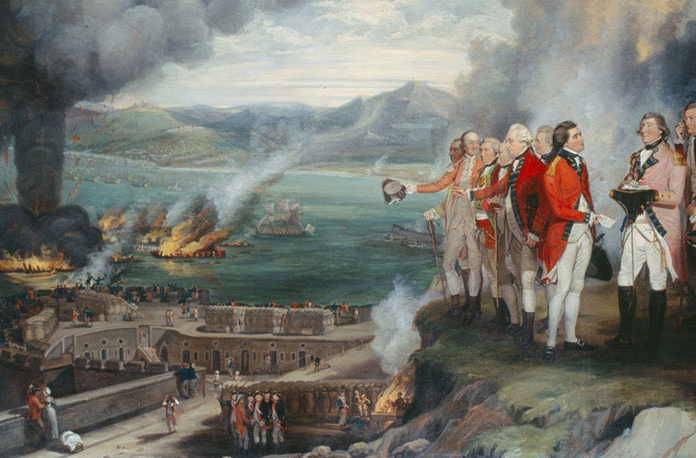During and immediately after the Revolutionary War, artists in America and Europe painted scenes of some of its pivotal events—some to display national or individual pride, others to make a profit and others still to reveal the brutality of war. Often using eyewitness accounts and their own observations of the setting, these artists created paintings with accurate details as well as emotionally evocative scenes. They are among the best sources we have to convey what events and places of the Revolution looked like. They also remind us to ask why these works were created and what memorializing these scenes meant to the people who commissioned them, the artists who painted them and the viewers who gazed upon them. This list of ten great Revolutionary War paintings—highlighting works in both American and European collections—follows the course of the war through dramatic and compelling scenes of struggle, violence and triumph that illuminate the vast scope of this world-wide conflict.
June 1775
The Battle of Bunker’s Hill, June 17, 1775 by John Trumbull, 1786
Yale University Art Gallery
The Battle of Bunker Hill was the first major battle of the Revolutionary War, occurring two months after the opening battles at Lexington and Concord and the beginning of the patriot siege of Boston. In response to patriot troops taking up positions on Breed’s Hill overlooking Boston, the British sent three thousand men to dislodge the Americans and take the hill for themselves. Three waves of professional British soldiers advanced up the hillside before the patriots abandoned their positions, having inflicted heavy casualties on the enemy. The surprisingly effective conduct of the patriot troops at Bunker Hill encouraged American enlistments and discouraged the British from attempting another assault, allowing the newly formed Continental Army to maintain the Siege of Boston until the arrival of Henry Knox’s artillery train in March 1776 finally forced the British to evacuate the city. The Battle of Bunker Hill was the subject of John Trumbull’s first canvas in a series of history paintings of principal events of the American Revolution. Completed in 1786, Trumbull’s oil painting depicts the climax of the battle, when the British overran the American redoubt and the patriots were forced to retreat. One of the last men left facing the enemy was Dr. Joseph Warren, a leader of the patriot resistance to British tyranny in Boston who fought at Bunker Hill as an ordinary private, despite having been appointed a major general of the Massachusetts militia a few days earlier. His death at the hands of the British—making him the first martyred hero of the Revolution—is the central event of the painting. Warren’s lifeless body is cradled by his fellow patriots, recalling images of Christ having been removed from the cross and Benjamin West’s portrayal of British general James Wolfe dying on the Plains of Abraham during the French and Indian War—all symbols of heroic sacrifice for one’s ideals. Trumbull organized the events of the day—which he observed from afar and heard about from participants—into a familiar artistic framework that conveyed to his audience one of the ideals of the Revolution. The painting’s sweeping elegance and intimate action have made it one of the most familiar images of the Revolutionary War.
View the Whole Painting
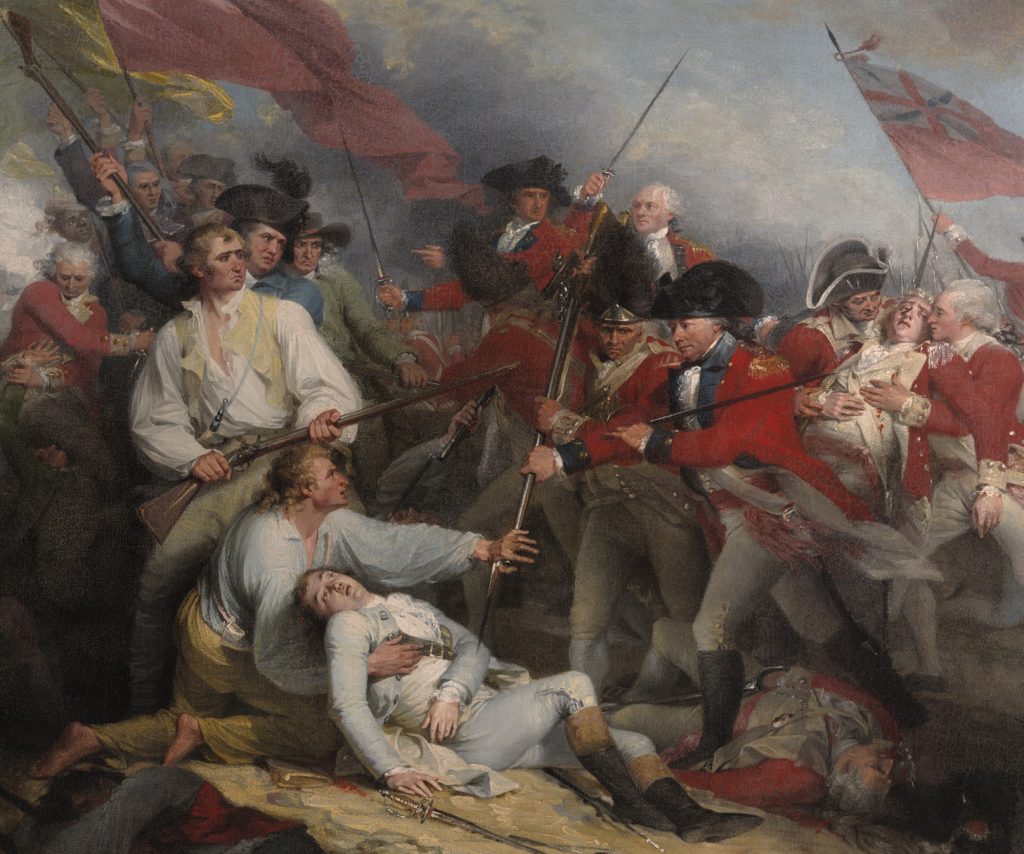
December 1775
The Death of General Montgomery in the Attack on Quebec, December 31, 1775 by John Trumbull, 1786
Yale University Art Gallery
John Trumbull’s second history painting of the Revolution remains less familiar than his view of Bunker Hill, but it is similarly compelling. With this canvas, Trumbull memorialized the death of Maj. Gen. Richard Montgomery, one of the most experienced soldiers in the Continental Army and the leader of the American campaign against the British in Canada. After an unsuccessful siege of the walled city of Quebec, General Montgomery ordered his men to attack during a blizzard. As dawn broke on New Year’s Eve of 1775, a barrage of British gunfire killed Montgomery and sent his troops into a panicked retreat. The Canadian campaign had failed, but Montgomery was enshrined among the heroes of the American Revolution. For his oil painting of the battle, Trumbull again chose to depict the moment of the martyred hero’s death, using the same symbolic composition as he did for the death of General Warren. Trumbull’s painting of the action at Quebec is somewhat simplified, with fewer figures and larger areas of plain cloudy skies and snow-covered ground. His use of light creates a more dramatic scene, with Montgomery’s body bathed in light as the focal point of the composition, while large swaths of the painting are darkened by shadows. The mood of the wintry scene is more somber and uncertain, while still celebrating an American hero’s ultimate sacrifice to the fight for American liberty.
View the Whole Painting
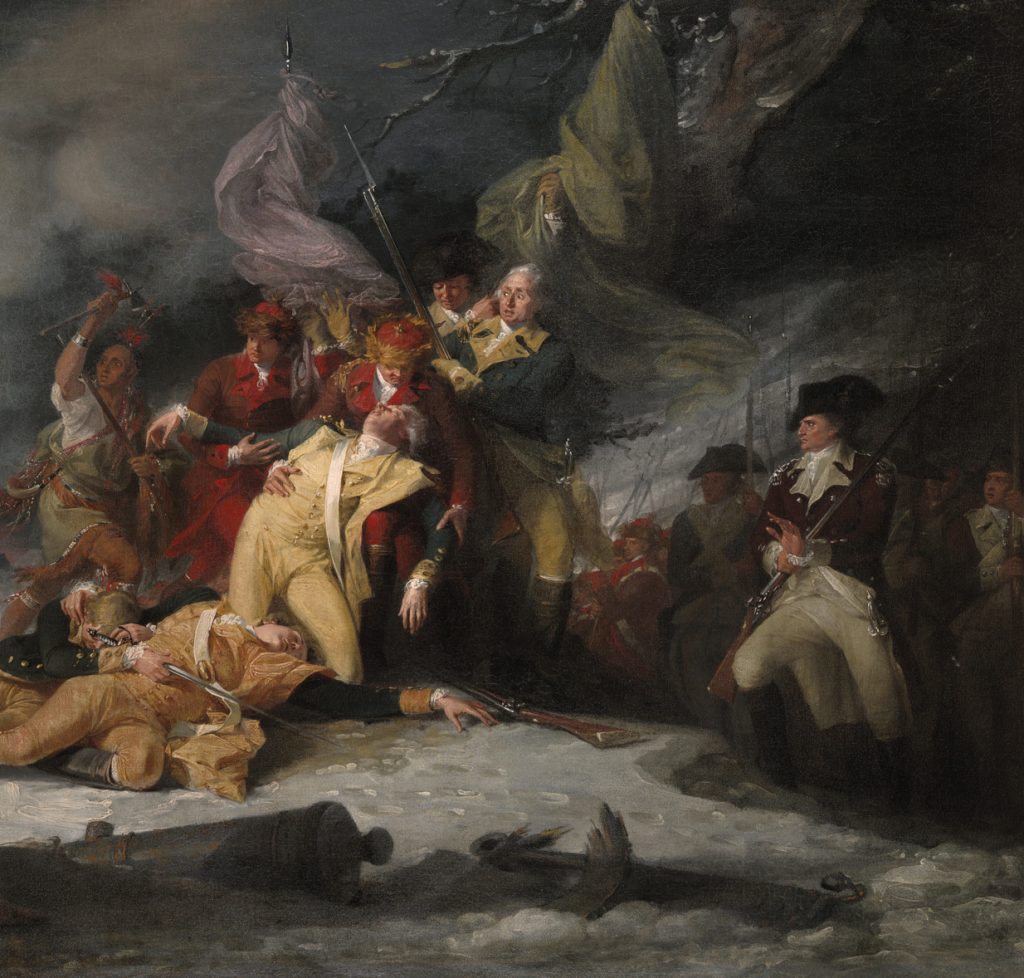
June 1776
The Unsuccessful Attack on the Fort on Sullivan’s Island by Henry Gray, 1776
Gibbes Museum of Art
In an attempt to reestablish royal authority in the southern colonies, a powerful British squadron approached Charleston Harbor on June 28, 1776, intent on subduing the city. Instead, four hundred South Carolinians manning an unfinished fort made of palmetto logs on Sullivan’s Island drove off the fleet. The battle was the Bunker Hill of the South, helping to persuade Americans that their troops could successfully resist the British military. Lt. Henry Gray fought in the battle and was wounded while manning a gun in the parapets of the fort. Shortly afterwards, he painted two panoramic watercolor scenes of the attack and the morning after, based on what he had witnessed. Gray’s painting presents a view of the battle from an offshore point just northwest of the fort, as if from a ship or boat—not a perspective he had during the attack but one that effectively conveys the overall scope of the engagement. He pictured at least six of the attacking warships bombarding the fort, with the smoke from both sides prominent in the scene. A blue flag with a silver crescent in the corner flies over the fort, soon to be struck down by a British cannonball only to be returned to the flagstaff by the gallant Sgt. William Jasper. Gray gave the paintings to Richard Bohun Baker, his comrade in the Second South Carolina Regiment who would become the last surviving officer of the Battle of Sullivan’s Island.
View the Whole Painting
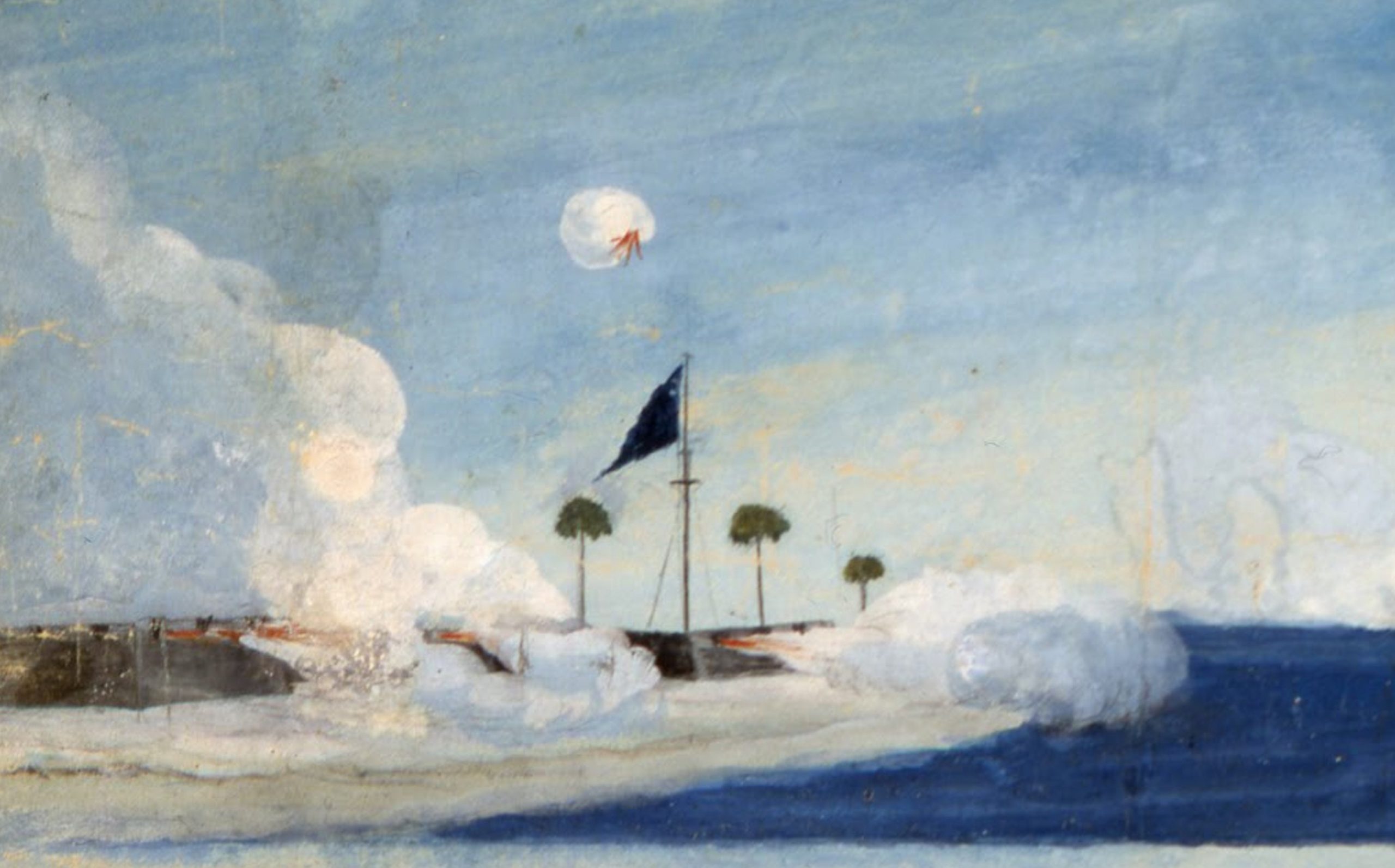
January 1777
The Battle of Princeton by James Peale, ca. 1782
Princeton University Art Museum
George Washington’s first battlefield victory over British troops at Princeton, New Jersey, inspired several artists, during and after the war, to memorialize the battle on canvas. This oil painting by James Peale, a member of a renowned family of artists from Maryland, compresses the events of January 3, 1777, into a single scene. He emphasized the critical moment when Washington—in the center foreground accompanied by his blue headquarters flag—rode onto the battlefield, rallied the men and led the final attack on the British lines. To the right, a crew from Capt. Joseph Moulder’s battery fires a cannon at the British soldiers positioned at the fence line in the distance. In the middle distance, Brig. Gen. Hugh Mercer, who was mortally wounded during the first American advance on the British lines earlier in the day, lies on the ground next to his fallen horse. Peale tried to depict numerous details as realistically as he could, including the specifications of the American uniforms, the equipment of the gun crew and even the color of Washington’s horse. The artist was also a soldier, serving as a first lieutenant in the First Maryland Regiment at the battle, and composed his painting from his recollections of the day. He would have also had access to the sketches of the site that his brother, Charles Willson Peale, made in 1779 while preparing to paint a full-length portrait of Washington at Princeton. James Peale completed his painting of Princeton five years after the engagement, probably for himself to commemorate a battle in which he and his brother fought.
View the Whole Painting
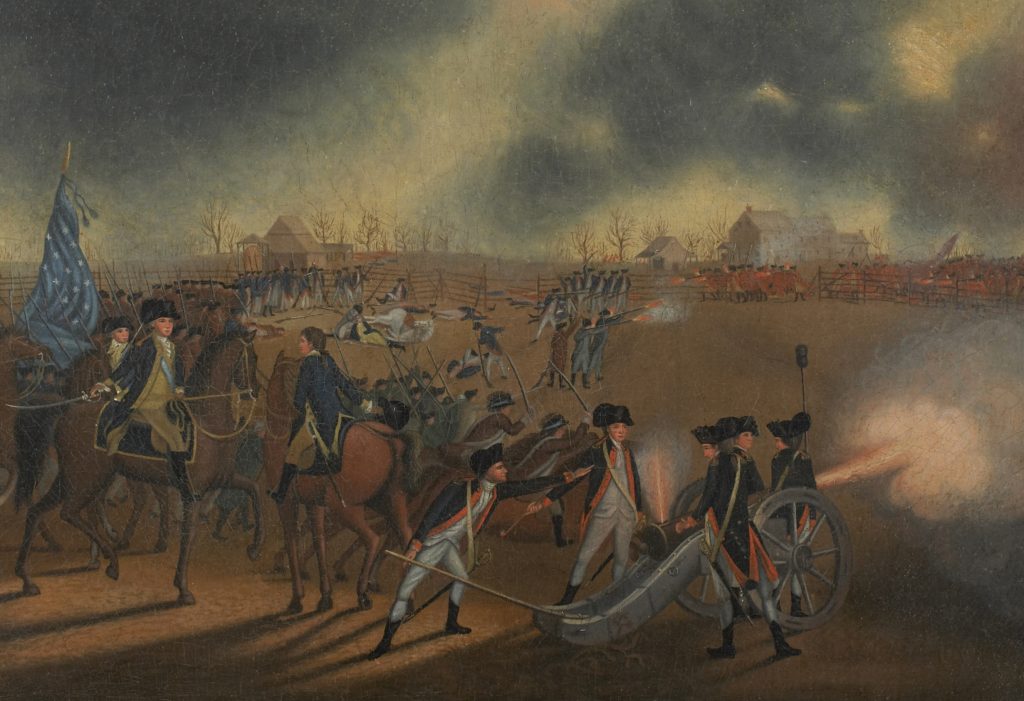
September 1777
Battle of Paoli by Xavier della Gatta, 1782
Museum of the American Revolution
This depiction of the nighttime attack at Paoli, Pennsylvania, is one of the more unusual Revolutionary War paintings. It is a rare depiction of a nighttime engagement and was commissioned by a participant in the battle for his own use, when many of these kinds of paintings were commissioned by governments or organizations for public display. On the night of September 20-21, 1777, British light dragoons and infantrymen launched a surprise attack on Brig. Gen. Anthony Wayne’s division of the Continental Army, which was camped in a field northwest of Philadelphia. In the Battle of Paoli, also known as the Paoli Massacre, the British soldiers took advantage of the Americans’ exposed position to inflict heavy casualties on Wayne’s men. One of the participants, Lt. Richard St. George of the light infantry company of the British army’s Fifty-Second Regiment, commissioned Italian artist Xavier della Gatta to paint a gouache scene of the Battle of Paoli, along with one of the subsequent action at Germantown. St. George traveled to Italy at the end of his service and provided his own accounts of the battles and the sketches he made while on campaign in America to help della Gatta create the works. The artist’s composition of the Battle of Paoli emphasizes the brutality and confusion of the surprise attack. Along the foreground, British light dragoons, riflemen and infantrymen use sabers and bayonets to cut down American troops, who in return fire their muskets, revealing their positions in the dark. Similar scenes occur across the battlefield farther in the distance. Della Gatta merged these events—which occurred at different times during the battle—into a single tableau to provide a comprehensive view of what St. George called “a nocturnal bloody scene.” St. George kept the paintings at his home in Ireland as a reminder of his experiences in the American war.
View the Whole Painting
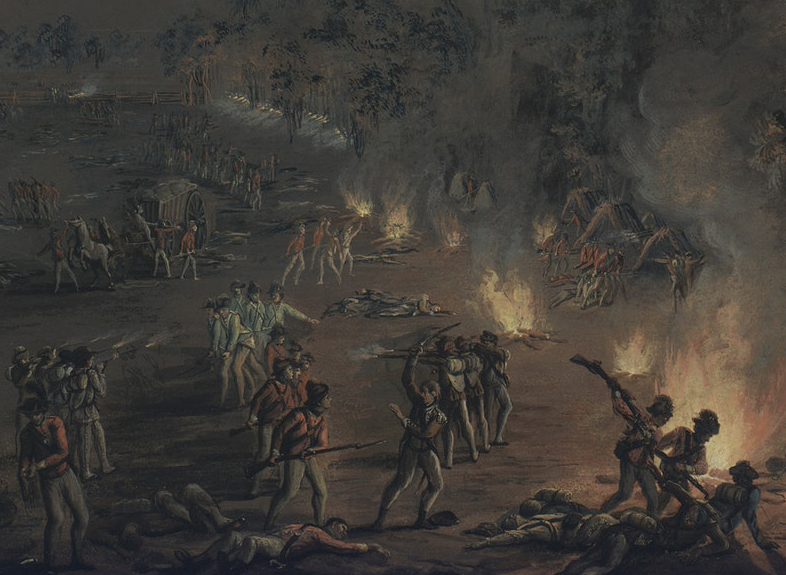
October 1779
The Surveillante in Action Against the Quebec, 6 October 1779 by Auguste-Louis Rossel de Cercy, 1789
Musée National de la Marine
In 1786 King Louis XVI commissioned Auguste-Louis Rossel de Cercy to paint scenes of the principal naval battles of the American war to honor French officers’ skills and bravery—conduct that had “added lustre to the glory of the nation.” Rossel had only started painting during the American Revolution, after retiring from a twenty-eight-year career in the French navy, but he quickly became adept at depicting naval subjects. This oil painting of Surveillante in action against HMS Quebec was one of sixteen original works he completed for the royal commission. The engagement near the mouth of the English Channel was one of the fiercest naval duels of the war, with both ships losing their masts and catching fire. The crew of Surveillante was able to put out the flames, but Quebec exploded. In a display of compassion, the French gathered the British survivors and together they made it to the port of Brest. Rossel chose to depict the moment of the explosion on Quebec, with some British sailors attempting to flee the wreckage and others already adrift in the water. French sailors begin their rescue from a small boat in the foreground. The rough seas and gathering clouds add to the drama of the scene. The artist probably created his composition using accounts of French survivors of the ordeal as well as earlier depictions of the event, at least one of which had been published as an engraving. Rossel’s original paintings for the royal commission—now preserved in the collections of the Musée National de la Marine and the Château de Versailles—were to be displayed at the three primary French naval schools as examples of virtue and valor. The commission also included copies of each work—painted by other artists under Rossel’s direction—to present to the commanding officers honored in the paintings.
View the Whole Painting
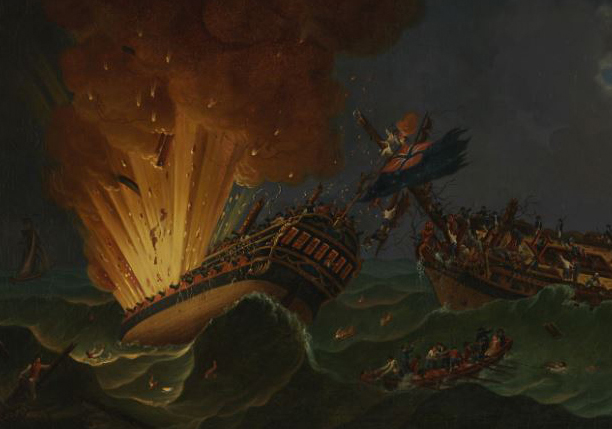
January 1781
The Death of Major Peirson, 6 January 1781 by John Singleton Copley, 1783
Tate Britain
John Singleton Copley celebrated heroic sacrifice and national glory in this painting of the death of Maj. Francis Peirson during the British defense of Jersey in early January 1781. The French attempt to seize the island just off the coast of Normandy failed when troops from the British garrison and local militia organized a counterattack and defeated the invading force. Major Peirson, who led the British forces, was killed by a French sniper before the battle in Royal Square. News of the victory, although a minor one in the overall course of the war, was embraced by the British people, who were growing weary of the lengthy conflict in America. To capitalize on the excitement, London engraver and bookseller John Boydell engaged Copley to create a painting of the event. A Boston native who settled in London just before the war, Copley was one of the most important artists of the revolutionary era. At the center of his large oil painting he placed twenty-four-year-old Major Peirson at the moment of his death—a martyred hero in the same tradition as Benjamin West’s General Wolfe and John Trumbull’s General Warren. Copley depicted Peirson’s death in the chaotic battle in the square to add to the drama. To the left of the central group stands a black soldier—identified as Major Peirson’s servant—firing towards the French lines to avenge his leader. The public success of the painting, first exhibited in London in May 1784, and the engraving, published in 1796, elevated this minor engagement on Jersey to one of the best remembered of the Revolutionary War in Great Britain.
View the Whole Painting
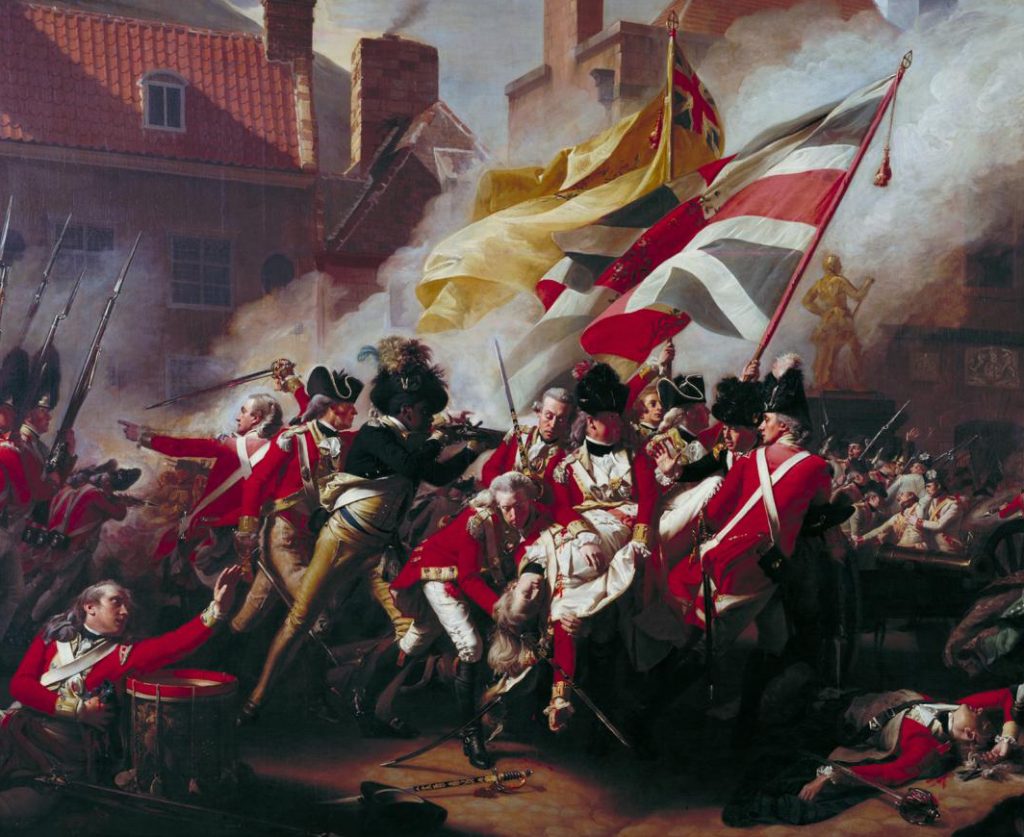
October 1781
The Capture of Yorktown, 19 October 1781 by Louis-Nicolas van Blarenberghe, 1785
Château de Versailles
To memorialize the most important French-American victory of the war, Louis XVI commissioned two gouache paintings of the siege and surrender at Yorktown, where the British lost the war for their American colonies. The commission went to Louis-Nicolas van Blarenberghe, the painter of battles for the War Department and a member of a prominent Flemish family of artists. Van Blarenberghe embraced the traditional style of eighteenth-century European battle paintings: panoramic, bird’s-eye views that offer a sweeping overview of the engagement, emphasizing the enormity of the scene in a detailed, dispassionate composition. To create the scenes, he studied plans and maps of the siege, especially the topographical data collected by Alexandre Berthier, an engineer on General Rochambeau’s staff. Van Blarenberghe’s painting of the surrender on October 19, 1781, depicts the British troops marching out of Yorktown towards the surrender field, with the town and York River faintly in the distance. The landscape of wide expanses with few trees resembles Flanders or Italy more than Virginia, and serves the picturesque aesthetic of the work more than its accuracy. But many of the painting’s minute details—drawn with the help of a magnifying glass—are faithful representations of the surrender scene, from the ranks of French and American soldiers flanking the marching British troops to their uniforms, flags and weapons. The Yorktown paintings hung in the king’s private apartments at the palace of Versailles—a daily reminder of the critical French role in the monumental victory over his enemy. Louis XVI also commissioned replicas of the paintings for Rochambeau, which he presented in 1786.
View the Whole Painting
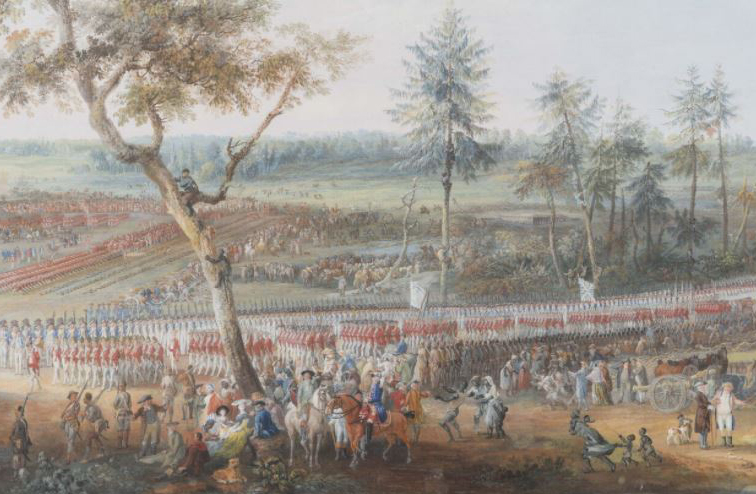
April 1782
The Close of the Battle of the Saints by Nicholas Pocock, ca. 1782
Bristol Museum & Art Gallery
After Yorktown, the main theater of the war shifted to the Caribbean, where Britain and France—and, to a lesser extent, Spain and the Netherlands—fought over their lucrative sugar islands. In April 1782 a British fleet under Admiral George Rodney intercepted a French fleet commanded by Admiral de Grasse near the Îles des Saintes, a group of small islands a few miles north of Dominica. The Battle of the Saintes was a disaster for the French navy, which saw casualties higher than those sustained by French, British or American forces in any other battle of the war. The momentous victory became one of the most popular events of the war for British artists to depict, many of whom were commissioned by officers who had served in the battle. Nicholas Pocock was one of the most successful of these artists, producing numerous oil and watercolor scenes of the battle through the 1780s and 1790s. For this oil painting—one of Pocock’s first of the subject—he collaborated with shipbuilder James Martin Hilhouse, who had invaluable knowledge of naval engineering. Pocock was also familiar with ships and the Caribbean, having served on British merchant vessels in the region for much of the 1760s and 1770s—including Dominica, which he visited five times. The scene depicts the French defeat, with de Grasse’s flagship, Ville de Paris, at the right, its sails faltering, surrendering to HMS Barfleur commanded by Admiral Samuel Hood. Pocock’s treatment of the scene—particularly his use of light and shadow—is dramatic yet restrained, injecting an immediacy often missing from his rivals’ versions. Admiral Hood’s brother Alexander commissioned another painting of the Battle of the Saintes from Pocock in 1784 that remains in the family’s collection.
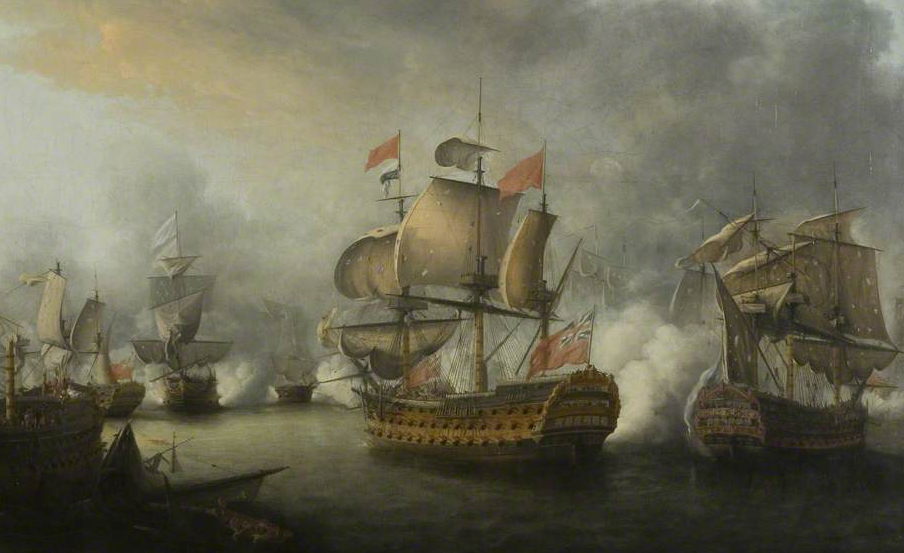
September 1782
General Eliott and His Officers Observing the Destruction of the Floating Batteries, Gibraltar, 14 September 1782 by George Carter, 1784
National Army Museum, London
The British triumph at Gibraltar was one of its most celebrated and often-depicted victories of the American war. From 1779 to 1783, Spanish and French forces besieged British-held Gibraltar in the longest and largest engagement of the Revolutionary War—one that diverted British resources from North America. For his oil painting of the siege, English artist George Carter chose to depict the climatic event in September 1782 when Spanish and French warships and floating batteries, vessels that were modified to serve solely as heavy artillery batteries, mounted a failed attack on the Rock. Carter, whose works were influenced by his rival John Singleton Copley, was known for his paintings of contemporary events. His Gibraltar composition is both a literal history painting and symbolic allegory. A realistic portrayal of the British destruction of the floating batteries, which caught fire and exploded in the bay, fills the left side of the painting. On the right, a contrived assemblage of British officers looks on, honoring the men who led Britain to victory at Gibraltar—a success that helped counter the sting of the defeat at Yorktown. The group is led by Gen. George Eliott, governor of Gibraltar and commander of its garrison, shown at the center of the group wearing a pale red coat. Carter worked to depict the details of the painting as true to life as possible. For his view of the battle scene, he consulted government papers as well as Sir Roger Curtis, a British naval officer who helped rescue hundreds of Spanish sailors from the burning floating batteries. For the grouping of military leaders, Carter made portrait studies from life of the figures, some completed when he visited Gibraltar soon after the siege. (His portrait of senior engineer William Green is in the Institute’s collections.) With this work Carter hoped to win the City of London commission for a large painting of the siege. Though the commission went to John Singleton Copley instead, Carter’s composition influenced the more famous depictions of the siege by Copley and John Trumbull.
View the Whole Painting
